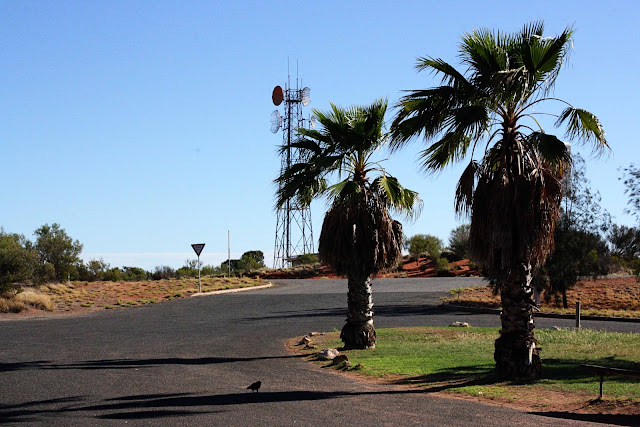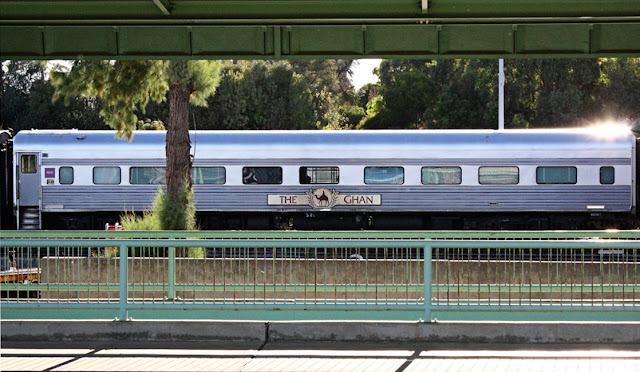My goodness me. I have been racking up the kilometres of late (good) but not blogging (bad). Also my camera is not working, which may be pique as a result of the 800 photos I took on my trip to the Northern Territory. However, there will be many posts to come about my adventures, starting now.
When last I posted I was waiting to board the Ghan - the train that travels from Adelaide at the bottom of Australia (in the handily named state of South Australia), over 3000km to Darwin (at the 'Top End' of the Northern Territory - those Australians don't seem to have much imagination for names.) I was booked to go from Adelaide to Alice Springs and really, if you want a sense of just how vast Australia is, the train is far and away the best way to travel.
I had booked myself on a recliner chair (cheapest option) for reasons of pure economy. The Ghan isn't cheap and I didn't feel like paying upwards of $1000 for a cabin. The chairs are fine, but I warn any would-be train travellers that the 'Red' class accommodation on the train is fairly basic.
My sense is that the operators are trying to rebrand the train more as a luxury travel option so most of the train was given over to the 'Gold' and 'Platinum' coaches. That all said, my seat was comfortable, and the views spectacular. The only down side was the food available, which was pretty grim: sausage rolls in plastic and packets of cornflakes. BIG HINT: bring a picnic! Still, the retro green interior of the cafe appealed to me.
For $10 extra chair-travellers (as opposed to those booked into cabins) could sit in the observation lounge, which I did and where I spent most of the journey, surrounded by friendly Danes. They adopted me as their own and we discussed Borgen and The Killing, and specifically whether Sarah Lund-style jumpers might be required for cold Outback nights.
So,
you leave the Pennsylvania Station ‘bout
a quarter to four, read a magazine and then you’re in Baltimore you leave Adelaide at lunchtime and at first the train passes through fairly typical industrial areas.
After an hour or so (at a top speed of ~60kmph this is not a fast way to travel), industrial suburbs give way to farmland.
This was the moment when the train (781m long) went around a bend and from my vantage point towards the back I could see the whole thing:
After nearly four hours we reached Port Augusta, where the Outback meets the sea and where the train stopped for a little while. Port Augusta was once the terminus for the North/South transcontinental railway and an important hub for anyone heading into the Territory.
It's still a hub for freight:
After Port Augusta, the earth started to get noticeably redder, though still not as intense a hue as I was expecting from the Red Centre.
As the shadows grew longer, I amused myself by taking photos of the train's reflection.
The Stuart Highway (main North/South road) runs alongside the railway for much of the journey and occasionally we would see road trains (ie lorries pulling two or three tankers/trailers).
Sunset was around 8pm - and I went to bed not long after, tired from my early start - plus once it's dark in the Outback, it's really dark.
I slept on and off, waking up occasionally when the train stopped (cows on the line? break for the driver? not really sure.) I woke up fully around 5 (or, 5 in the Northern Territory, 5.30 in South Australia and 6.30 in Melbourne. Complicated time zones.) Just in time to catch the dawn.
And once it was light enough to see the ground, it was clear that it was, yes, truly and unmistakably red. Not just that, but we were in full-on desert: no people, no buildings, no roads, just scrubby trees and red sand.
Oh, and occasional cows.
As the morning progressed, we started to see a few more signs of what you could loosely call civilisation: this road, for example - which is shown on the maps as a reasonably major byway ...
We also passed a few rivers - yep, rivers.
I learnt that in this part of the world, rivers flow inland, not out to the ocean. During the 'big wet' (i.e. the wet monsoon season) rainfall collects and flows inland to fill the dry creek beds. But obviously nothing was flowing when we passed.
I also noticed that the colours weren't as monochromatic as I expected. For all that it's desert country, it's semi-arid desert and there's a surprising range of greenery.
Eventually, 26 hours after setting off, we arrived into Alice Springs. But that's a story for next week.
The Ghan is not the most comfortable way to travel across Australia (at least not if you're travelling economy class) and it's not the fastest way to travel across Australia (flying, even driving, much quicker) and if you get bored easily it might not be for you (no in-flight entertainment and the recliner-seat carriage doesn't have power points). To put it in perspective, the 26 hours the train takes (and that's only half the journey - Darwin is another day and a half beyond that) is longer than the time it takes to fly from Australia to Ireland.
But if, like me, you love the idea of experiencing Australia's hugeness and understanding how it changes between the coastal cities and the vast interior ... if you want to fall asleep in one landscape and wake up in another ... if you are enchanted at the idea of arriving at one of the remotest cities on the planet by train ... if you can gaze for hours at the subtle shifts in the colour of the ground outside your window ... then the Ghan is most certainly for you.















































